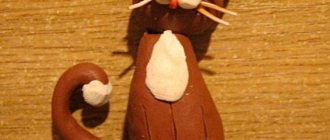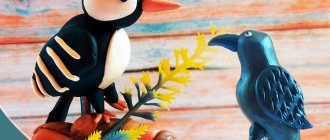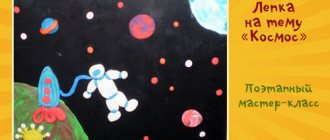Summary of GCD on modeling on the topic: “Felt boots” in the senior group
Goal: to teach children to sculpt felt boots in an unconventional way - plasticineography.
Tasks:
Educational:
1. To develop skills in working in the plasticineography technique - pinching, smearing, decorating the product using (beads, rhinestones, seed beads, sequins).
2. Enriching and updating children’s knowledge about the variety of shoes, their purpose, and use depending on the time of year.
Correctional and developmental:
1. Development of fine motor skills of the hands.
2. Development of perception and sensation.
3. Development of mental operations and inferences.
4. Form nouns with a diminutive suffix.
Educational:
1. Cultivate accuracy in work.
2. Formation of perseverance.
Integration of educational areas:
NGO “Cognitive Development”, NGO “Artistic and Aesthetic Development”, NGO “Speech Development”, NGO “Physical Development”.
Preliminary work : work on a lexical topic, looking at illustrations with different types of shoes, reading K. Chukovsky’s “Miracle Tree”.
Forms of educational activities : subgroup, gaming, communicative.
Methods and techniques : verbal, practical, visual.
Materials and equipment:
For the teacher : pictures with shoes, sample “Felt boots”.
For children: plasticine, napkins, additional material for decorating the work, “Felt felt boots” templates.
Progress of the lesson:
Organizing time:
Children stand in a circle We came to kindergarten (imitate walking) Gosha is happy and Tikhon is happy, And of course all the guys (clap our hands) We are very happy to meet you! Guys, I’m glad to see you so cheerful and healthy, how are you feeling? May your good mood remain with you all day. Give a smile and good mood to our guests.
Main part.
Educator:
The phone rings. The teacher picks up the phone and answers:
- Hello? Who's speaking? An old man from a forest hut? What has happened with you?
Guys, the Old Forester cannot find his shoes, he looked for them under the stove, and under the table, and under the bench - they are nowhere to be found. How can he now get around his forest possessions? What advice would you give him? (Children's answers.)
Guys, what are shoes even for? Is it possible to do without it? (Children's answers.)
Lesovichok said that he had sandals and would wear them on the street in winter. Is it possible to walk through the forest in sandals in winter? Children: no! because it will freeze.
Educator: Of course, guys, what kind of shoes should you wear in winter? (in winter).
Educator: Well, guys, let’s help the forester? (Yes.) Now I’ll call him: Hello, Lesovichok, don’t worry. We will definitely help you. The skillful hands of our children will make new winter shoes for you.
Educator: Guys, our little forest boy is small, which means his shoes are small, and if we have galoshes, then the little forest boy has sneakers, sneakers, shoes, sandals, sandals, boots, boots, felt boots) - GAME WITH A BALL.
Educator: And now, guys, I’ll tell you a riddle. Mystery:
An adult knows
Even the little one knows
So as not to get sick in winter.
They put on …. (felt boots).
Educator: of course, guys, these are felt boots, frosts and snowstorms are not scary in felt boots, these are very warm shoes. They are made from natural sheep wool. And today we will make unusual felt boots, and in an unusual way - from plasticine. And to make the felt boots beautiful, we will decorate them (with beads, beads, sequins). But first we'll take a little rest
Now sit down at the tables and you and I will become master shoe designers, we will make and decorate felt boots.
The teacher shows the sample, examines it, and explains the teacher.
Look, the felt boots have a wide shaft, a flat sole and a rounded toe. For my felt boots, I chose green plasticine and decorated it with sequins and beads.
— Before starting work, you need to choose the plasticine that you like, apply the plasticine to the felt boot template. After pinching off a piece and applying it to the cardboard, after finishing this work, we will begin decorating the felt boots. You will come up with the patterns yourself, but you must remember that the pattern must be beautiful.
But before we get started, we'll play with our fingers.
Finger gymnastics:
One, two, three, four, five Let's count shoes: One - shoes, The child bends his fingers. Two - boots, Three boots, Four - sandals And, of course, slippers - five. Hands need to rest. (After finger gymnastics, the teacher and the children begin to work.) Look at how to do it. I pinch off a piece of plasticine and stick it to the cardboard. Educator: look at the fabulous felt boots you got. Guys, do you think the Old Forest Man will like your work? Let's put them in a box and send the parcel to the forest.
Final part.
Educator:
— What did you like most?
- What have we learned today?
Reflection.
Children choose emoticons and take them for themselves (smile - they liked the activity, sad - they did not like the activity.
Summary of the lesson on modeling "Grandmother's Tales"
Bulanova Galina Anatolyevna
Summary of the lesson on modeling “Grandma's Tales”
Senior group teacher
MAOU secondary school No. 28 in Kaliningrad
Bulanova Galina Anatolevna
Lesson notes.
Modeling " Grandma's Tales "
.
Goal: consolidating children’s knowledge about Russian folk tales , training in testoplasty.
1. Teach children to sculpt from colored dough based on Russian folk tales (log house)
.
2. Teach how to independently determine the methods and techniques of modeling depending on the fairy tale plot .
3. Develop compositional abilities, reflect in your work your attitude towards the heroes of the fairy tale .
4. Cultivate artistic taste, independence, and creative initiative.
5. Using the example of folklore works, cultivate interest in Russian culture, language, and music.
Preliminary work: conversation, literary quiz on Russian folk tales ; reading Russian folk tales . Examination of fairy-tale illustrations in children's books. Introduction to testoplasty.
Materials, tools, equipment: colored, salted dough; modeling boards , trays, napkins, Baba Yaga doll; images of houses (teremka, ice palace, hut on chicken legs)
;
a casket with props from fairy tales ; markers or colored pencils.
Children of the preparatory group for school sculpt on the theme “Grandmother's Tales”
Oksana Telikova
Children of the preparatory group for school sculpt on the theme “Grandmother's Tales”
Have a fabulous winter evening to everyone who stopped by!
Some colleagues know that I am a teacher by profession. I would like to present to your attention the “Book of Fairy Tale Riddles” that my third graders and I created while working on the topic “Adjective”.
She invited the children to illustrate a riddle for any fairy tale or fairy-tale character. An indispensable condition was the presence of adjectives in the riddle. The children have grown up, they are now 20 years old, and I still remember who drew which page and the handwriting (the riddle is written on the back). Of course, now I use this book in my work. During modeling classes on the topic “Visiting a Fairy Tale,” she helps me out a lot. I publish the riddles that we came up with with the guys in this article. I hope you find them useful too!
Russian folk tales and their heroes
"Sister Alyonushka and brother Ivanushka"
There is a hero in a folk tale,
He is three-headed, scary, evil!
He kidnaps red maidens
He takes the distant one to his own land!
Author's fairy tales and their heroes
"The Tale of the Fisherman and the Fish"
He lives in the Ural tale,
When he kicks with his foot,
It's from under his hooves
The diamond stone flies.
Foreign fairy tales and their heroes
A cheerful girl walks with a basket
And he brings cabbage pies for grandma.
A toothy top meets her from behind a bush.
Tell me, now that you know, who is that girl?
Today I conducted a lesson on plot modeling with the children of the preparatory group on the topic “Grandmother’s Tales.”
The tasks were set as follows:
Teach children to sculpt based on Russian folk tales: independently choose an individual character or plot, determine the methods and techniques of sculpting, depending on the nature of the image, give the characters fabulous external recognizable features, elements of costume, and interior design.
Develop abilities for plotting and composition.
To cultivate artistic taste, independence, creativity
What the children did after they guessed the riddles to Russian folk tales from the “Book of Fairytale Riddles”, look further.
"Fox with a rolling pin"
Cockerel and Firebird
“Geese-Swans” and, of course, “Kolobok”!
It is very easy to analyze children's crafts and the development of skills in such classes!
Thanks to EVERYONE who made it to the end!
"We are the children of the Earth." Ecological entertainment for children of the preparatory school group “We are the children of the Earth” Ecological entertainment for children of the preparatory school group Developed by: O. A. Witt, music director.
Photo report about the project “Grandmother's Tales” Fairy tales are wise, instructive and moral. Consequently, they can help the child master the world of human feelings and relationships. So I.
Notes on the topic “Victory Day” for a preparatory school group. Goals: To enrich the spiritual world of children through reference to the heroic past of our country Objectives: Educational: To introduce events.
GCD summary for the preparatory school group “Sorceress Autumn” GCD summary for the preparatory school group on the theme “Sorceress Autumn” Form of implementation: KVN. Integration of educational areas:.
Summary of educational activities with Children of the preparatory group of TNR on the topic “Children and Theater” GOAL: The ability of children to master different types of theater (“Finger Theater”, “Petrushka Theater”, puppet theater “Bi-ba-bo”) based on Russian materials.
Premiere of the performance of the fairy tale “Turnip”. Participants are children of the preparatory group, spectators are children of the junior and middle groups. In MBDOU No. 153 in Izhevsk, a performance based on the fairy tale “Turnip” was shown for children of middle and primary preschool age. Preparatory children.
Scenario for a preparatory school group based on the Russian folk tale “Morozko” Characters: Storyteller, Morozko, Old Man, Old Woman, Marfusha, Nastenka, Ivan, Baba Yaga, Snow Maiden. Music is playing. Children come in. They are becoming.
Scenario for a New Year's party based on the fairy tale "The Nutcracker" for a preparatory school group: Presenter, Father Frost, Snow Maiden, Myshilda - adults. Minutes, Winter, Months, Nutcracker - children of the preparatory group. The presenters enter the hall.
Lesson for a preparatory school group in mathematics “On the paths of the fairy tale “Teremok”” FINAL LESSON IN THE PREPARATORY SCHOOL GROUP No. 7 “BEES” TOPIC: “ON THE PATHS OF THE FAIRY TALE “TEREMOK” TEACHER: MURATOVA SH. A Program.
Source
Progress of the lesson:
Storyteller : “Hello girls! Hello boys! I came to visit you and my name is Storyteller , because I tell people fairy tales .
The music is “Invitation to a Fairy Tale ”
.
Storyteller : “Guys, do you hear the music playing? These fairy tales call us on a fabulous journey . And a map of a fairyland . Let's take a closer look at where we need to go. (Looking at the map with children.)
Children go along the indicated route on the map.
First stop: “Terem with carved shutters”
.
Children find a birch scroll. The storyteller unfolds the scroll and says that the children need to guess from which fairy tales the passages are written in it (she reads out the passages, the children guess the name of
the fairy tales ) .
Storyteller : “Well done guys, you completed this task! Let's look at the map, it will tell us where to go next." (They look at the map, follow the route to the Ice Palace and find a casket with a lock).
Storyteller : “To open the lock you need to say the magic words “Cribly-crabble-boom”
(children repeat the magic words, the casket opens. It contains prop objects from various
fairy tales (an arrow, a crown, three wooden spoons, a bucket with a pike, etc.)
Storyteller : “Guys, help me guess which of the fairy-tale characters lost their things? (Children guess)
.
Well done, you completed this task, and now the map tells that we need to go to Teremok.”
The children approach the tower. The storyteller knocks on the door and a voice is heard: “Dear children, please help us, we have a problem. Baba Yaga flew in and bewitched us, now we can neither run, nor jump, nor walk. Only you can help us!
Storyteller : “Shall we help the inhabitants of the tower? Look what they're missing? Finish it." (Children fill in the missing parts of the animals.)
The animals of the tower thank the children for breaking their spell.
The guys are looking for the next stop on the map.
Stop “Hut on Chicken Legs”
.
The storyteller asks : “Guys, who lives in this hut?”
(children's answers)
In what
fairy tales is Baba Yaga found? (children's answers)
The storyteller offers to play with Baba Yaga.
Physical exercise “Grandma-Ezhka”
.(to the music of the author of the song Tatyana Morozov
“Grandma Ezhka”
)
Storyteller : “Guys, do you remember, during the dance, Baba Yaga invited us to visit? Let's go to? (children's answers)
.
Now tell me, what kind of character is Baba Yaga in fairy tales ? (children's answers)
.
Why do you think she is angry? (children's answers)
.
What kind of hut does Baba Yaga have? (children's answers)
.
Yes, indeed, guys, it is old and has never been renovated. How can we help Baba Yaga so that she is always in a good mood?” (children's answers)
.
The storyteller suggests making a new hut from colored dough. (Explains and shows individual techniques for working with salt dough.)
Children's work. During work, the teacher, together with the Baba Yaga doll, walks between the tables, encourages the children, and helps as needed.
At the end of the work, an exhibition of new huts for Baba Yaga is held. She thanks the children for the hut and says that in such beautiful houses she is in a completely different mood, and Baba Yaga decided to turn into a merry old woman. The storyteller thanks the children for helping the inhabitants of the fairyland .
Summary of the lesson on sculpting “Pears” Objectives of the lesson. Continue to teach children to pinch small pieces of plasticine from a piece and roll them into balls with a diameter of 7-10 mm, and apply pressure.
Children of the preparatory group for school are sculpting on the theme “Grandmother's Tales” Have a fabulous winter evening for everyone who stopped by! Some colleagues know that I am a teacher by profession. I would like to present to your attention. Photo report about the project “Grandmother's Tales” Fairy tales are wise, instructive and moral. Consequently, they can help the child master the world of human feelings and relationships. So I.
Synopsis of an integrated lesson on speech development and modeling for children 2–3 years old “Russian folk tales” MBDOU D/S 14 Municipal Education City of Goryachy Klyuch Educator: Svetlana Leonidovna Borisova Synopsis of an integrated lesson.
Summary of educational activities in the first junior group “Bowls for bears”. Modeling lesson based on the fairy tale by L. N. Tolstoy “The Three Bears” Types of children's activities: play, communication, cognitive-research, productive, perception of fiction.
Summary of the lesson in the second junior group “Visiting a fairy tale” within the framework of the project “Visiting a fairy tale” Program content: Consolidating a familiar fairy tale in children’s memory; Development of communication and creative skills.
Summary of the lesson on modeling “Bear cubs” Modeling from plasticine is an excellent activity in kindergarten. Modeling has many benefits for children's development. Develops fine motor skills.
Master class on modeling from salt dough “Heroes of the fairy tale “Mitten”” The purpose of the master class: to create conditions for the full manifestation and development of the pedagogical skills of the master class participants based on. Project activity in the middle group “Grandmother’s Tales” (based on the works of K. And Chukovsky) Project activity of the teacher Eremina Olga Leonardovna MADOU “Kindergarten No. 7”, Chernyakhovsk Topic: “Grandmother’s Tales” (based on creativity. Scenario of the joint event “Grandmother’s Tales "Scenario for a sweet evening with grandma "Tales from our grandmothers" Goal: Connecting generations through joint activities with children. Tasks: • Continue.
Source




